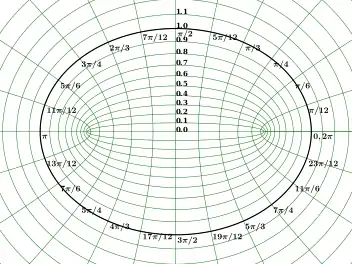Elliptic coordinate system
In geometry, the elliptic coordinate system is a two-dimensional orthogonal coordinate system in which the coordinate lines are confocal ellipses and hyperbolae. The two foci and are generally taken to be fixed at and , respectively, on the -axis of the Cartesian coordinate system.

Basic definition
The most common definition of elliptic coordinates is
where is a nonnegative real number and
On the complex plane, an equivalent relationship is
These definitions correspond to ellipses and hyperbolae. The trigonometric identity
shows that curves of constant form ellipses, whereas the hyperbolic trigonometric identity
shows that curves of constant form hyperbolae.
Scale factors
In an orthogonal coordinate system the lengths of the basis vectors are known as scale factors. The scale factors for the elliptic coordinates are equal to
Using the double argument identities for hyperbolic functions and trigonometric functions, the scale factors can be equivalently expressed as
Consequently, an infinitesimal element of area equals
and the Laplacian reads
Other differential operators such as and can be expressed in the coordinates by substituting the scale factors into the general formulae found in orthogonal coordinates.
Alternative definition
An alternative and geometrically intuitive set of elliptic coordinates are sometimes used, where and . Hence, the curves of constant are ellipses, whereas the curves of constant are hyperbolae. The coordinate must belong to the interval [-1, 1], whereas the coordinate must be greater than or equal to one.
The coordinates have a simple relation to the distances to the foci and . For any point in the plane, the sum of its distances to the foci equals , whereas their difference equals . Thus, the distance to is , whereas the distance to is . (Recall that and are located at and , respectively.)
A drawback of these coordinates is that the points with Cartesian coordinates (x,y) and (x,-y) have the same coordinates , so the conversion to Cartesian coordinates is not a function, but a multifunction.
Alternative scale factors
The scale factors for the alternative elliptic coordinates are
Hence, the infinitesimal area element becomes
and the Laplacian equals
Other differential operators such as and can be expressed in the coordinates by substituting the scale factors into the general formulae found in orthogonal coordinates.
Extrapolation to higher dimensions
Elliptic coordinates form the basis for several sets of three-dimensional orthogonal coordinates:
- The elliptic cylindrical coordinates are produced by projecting in the -direction.
- The prolate spheroidal coordinates are produced by rotating the elliptic coordinates about the -axis, i.e., the axis connecting the foci, whereas the oblate spheroidal coordinates are produced by rotating the elliptic coordinates about the -axis, i.e., the axis separating the foci.
- Ellipsoidal coordinates are a formal extension of elliptic coordinates into 3-dimensions, which is based on confocal ellipsoids, hyperboloids of one and two sheets.
Applications
The classic applications of elliptic coordinates are in solving partial differential equations, e.g., Laplace's equation or the Helmholtz equation, for which elliptic coordinates are a natural description of a system thus allowing a separation of variables in the partial differential equations. Some traditional examples are solving systems such as electrons orbiting a molecule or planetary orbits that have an elliptical shape.
The geometric properties of elliptic coordinates can also be useful. A typical example might involve an integration over all pairs of vectors and that sum to a fixed vector , where the integrand was a function of the vector lengths and . (In such a case, one would position between the two foci and aligned with the -axis, i.e., .) For concreteness, , and could represent the momenta of a particle and its decomposition products, respectively, and the integrand might involve the kinetic energies of the products (which are proportional to the squared lengths of the momenta).
See also
References
- "Elliptic coordinates", Encyclopedia of Mathematics, EMS Press, 2001 [1994]
- Korn GA and Korn TM. (1961) Mathematical Handbook for Scientists and Engineers, McGraw-Hill.
- Weisstein, Eric W. "Elliptic Cylindrical Coordinates." From MathWorld — A Wolfram Web Resource. http://mathworld.wolfram.com/EllipticCylindricalCoordinates.html